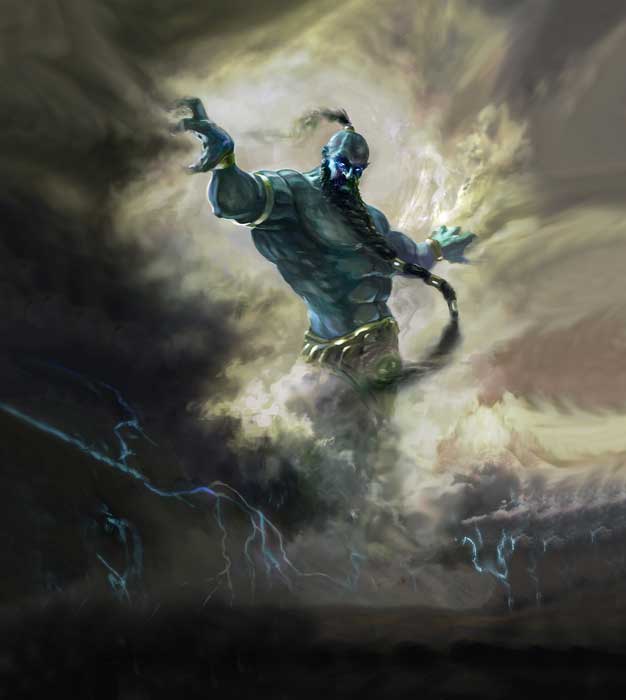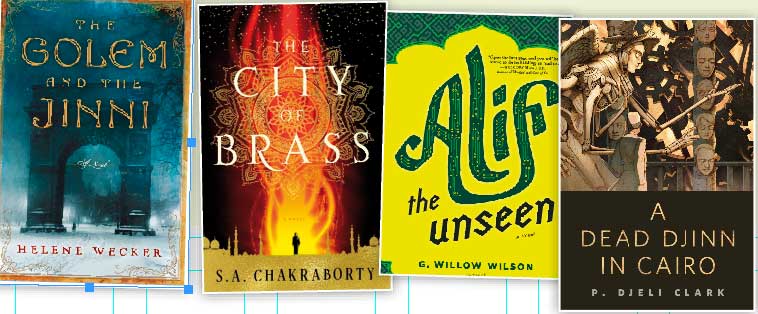Day of the Djinn
By Nudrat Kamal | Bookmark | Special Report | Published 7 years ago

Stories about djinns (also jinn) have always been part of the fabric of South Asian life. Everyone knows someone else who knows someone who has had an “encounter” with a djinn. There are warnings and directives about how to protect yourself from being possessed by djinns – don’t stand under trees after sunset; don’t go out wearing perfume after dark. Special rooms in mazaars are dedicated to exorcising djinns. Stories of pichal parris, with their feet turned the other way, and of abandoned houses in certain neighbourhoods being haunted, tend to circulate by word of mouth; they are recounted in hushed tones in darkened rooms late at night. It is easy to dismiss these djinn narratives as silly, quirky tales of superstition, told for cheap thrills and scares, tales that have nothing to do with our contemporary, modern lives.
Yet djinns have a long and illustrious history in literary and cultural tradition, not just in South Asia but also more globally — from the 8th century oral stories in the Arabian peninsula that were eventually compiled into Alif Layla (The Thousand and One Nights) and the 18th century Urdu Dastan-e-Amir Hamza of the subcontinent to the genies of romantic poets like Victor Hugo in Europe and the Robin Williams-voiced funny genie of Disney’s 1990s animated film Aladdin. The djinn in literature and popular culture around the world has had a variety of iterations, from the monstrous, mischievous and the sexually promiscuous djinns in oral stories and folktales of the Muslim world to the servile, humorous and wish-granting genies in Orientalist, western TV shows such as the 1960s’ I Dream of Jeannie. And now, in contemporary science fiction and fantasy (SFF), as Muslim and other non-white authors around the world, tired of creating worlds built primarily on white, Anglo-Saxon mythology, are turning to other cultural myths and folktales to create richer narratives, djinns are back in fashion.
In South Asia, too, a group of writers and editors have brought djinns back from the oral tradition of myth and urban legends into different genres of contemporary fiction, from SFF to horror and comedy. In the last two years, a significant amount of Anglophone fiction, in different genres, has emerged from the subcontinent that re-appropriates the djinn as a literary trope and refashions it to address contemporary concerns of South Asia and beyond.
South Asian Djinn Stories
1. The Djinn Falls in Love and other stories; editor Mahvesh Murad and Jared Shurin (2017): Djinn stories from around the world, including Nigeria, Singapore, Qatar and Scotland.
2. Djinn City, Saad Hossain (2017): A lonely boy in Dhaka discovers his dead mother was a djinn and his father was an emissary to the djinn community, and he must race against time to stop a djinn takeover of the world.
3. Boy of Fire and Earth, Sami Shah (2017): A half-djinn, half-human boy must brave the underbelly of Karachi and the land of djinns when his girlfriend is kidnapped.
4. Firefly in the Dark, Shazaf Fatima Haider (2018): A young girl meets her personal djinn, a prankster who helps her navigate a difficult time in her life.
5. The Jinn Darazgosh, Musharraf Ali Farooqi (2011): A fable relating how the curiosity of a djinn led to the usual unhappy results and brought about the closure of the heavens upon his race.
6. The Pauper Prince and the Eucalyptus Jinn, Usman T. Malik (2015): The story of a disenchanted young Pakistani professor who grew up and lives in the United States, but is haunted by the magical, mystical tales his grandfather told him of a princess and a djinn who lived in Lahore when the grandfather was a boy.
The first Anglophone South Asian djinn story appeared way back in 2011, when author Musharraf Ali Farooqi, ahead of this djinn comeback, published his short story The Jinn Darazgosh, but it wasn’t until last year that the djinn trend really took off. In 2017, Pakistani editor and critic, Mahvesh Murad, collaborated with fellow editor, Jared Shurin, to collect djinn stories from writers around the world in their brilliant anthology The Djinn Falls in Love and Other Stories. The anthology had djinn stories by writers from Morocco to Singapore to Qatar and Scotland, and it also featured Indian authors, an SFF writer from Bangladesh, Saad Hossain, and Pakistani writers such as Kamila Shamsie, Usman T. Malik and Sami Shah. Of these, Sami Shah and Saad Hossain went on to release their respective novels featuring djinns, Boy of Fire and Earth and Djinn City later that year. In 2018, Pakistani writers Shazaf Fatima Haider and Sarvat Hasin put their own spin on the djinn narrative in their sophomore novels, A Firefly in the Dark and You Can’t Go Home Again.
Newsline spoke to editor Murad and authors Shah, Malik, Haider and Hossain about why djinns are such a potent metaphor for exploring contemporary themes and concerns, and about why djinn stories are experiencing such a renaissance in contemporary South Asian fiction.
The first question, of course, was whether djinns ever really went away from literature and popular culture in South Asia in the first place. According to Malik, author of The Pauper Prince and the Eucalyptus Djinn, about a Mughal princess, a Pakistani expat and an ancient djinn in Lahore, there has always been an interest in djinn stories in Pakistan, even if it was not always reflected in the Anglophone fiction being written: “There is a dichotomy in Pakistan, a polarisation between the English-reading and Urdu and regional languages-reading world, which gives the illusion of a vanishing act of local mythos. Djinns are rampant in Urdu literature written for both adults and children: take, for example, the late Mazhar Kaleem’s Jinnati Duniya, some of Manto’s stories, Shahabnama, the hundreds of djinn stories published annually in Bachon Ki Duniya and other kiddie mags, as well as the thousands of pamphlets promising successful djinn exorcisms that litter our street corners. Djinns never went away; they waited patiently while Pakistani literature swung crazily from one extreme to another.”
 “South Asian people have always had a very matter of fact belief in djinns. To most of our people this is not mythology, but a tangible truth, and therefore there was almost no reason to write about it in a fantasy setting.”
“South Asian people have always had a very matter of fact belief in djinns. To most of our people this is not mythology, but a tangible truth, and therefore there was almost no reason to write about it in a fantasy setting.”
— Saad Hossain
Hossain, author of the darkly humorous and wonderfully strange Djinn City, explains that the situation is quite similar in Bangladesh. “South Asian people have always had a very matter of fact belief in djinns. To most of our people this is not mythology, but a tangible truth, and therefore there was almost no reason to write about it in a fantasy setting. While there is a very large and varied body of literature of all types being written in Bangla, what we see now I think is a flowering of djinn stories in English, but this is more because South Asian kids, who grew up in the ’80s and ’90s speaking primarily in English, are now becoming writers and they will inevitably use their own cultures at some point to flesh out their genre of fiction.”
Murad, who has edited several SFF anthologies and has her finger on the pulse of contemporary global SFF, feels that the addition of djinns in contemporary genres of fantasy and science fiction is an act of re-appropriation by our writers. “I suppose in some ways, this recent surge is a reclaiming of sorts, isn’t it?” she says. “Djinns have been present in various forms of narrative fiction coming from the West for years, be they Disney or Neil Gaiman [renowned American fantasy author], but now we’re taking back our power, telling the stories in the settings we want to see them in, as raw or ‘real’ as we want them to be, and with the sort of storytelling styles and syntax unique to us, hoping our narratives will break through to, and engage with larger readerships.” This reclaiming is particularly interesting if we look at the larger context of power and representation within which the figure of the djinn has circulated around the world.
The West’s appropriation of the djinn began to take place at the height of colonialism in the 18th century (the French translation of Alif Layla in 1717 was a defining moment), and their representation had all sorts of exoticised, Orientalised tropes attached to it. It can be argued that the West’s “de-fanging” of the formidable, free-willed djinn by turning it into the servile, enslaved and docile genie fit in well with its larger project of imperialism and colonisation. From this perspective, taking back control of the djinn has its own kind of power. Murad advises South Asian writers to, “Take control of your monsters, your demons, your djinns, and make them fight your battles for you. They’re your biggest strength.” And it speaks to the mutability of the djinn that it has had so many robust iterations. Shah, author of Boy of Fire and Earth, a novel that excels in combining Islamic mythology and the local djinn folklore of Karachi in a conventional western fantasy narrative, argues that it is no fluke that the djinn remains such a powerful mythological figure in literature: “It’s something about the fluid nature of djinns that allows that, or rather their flickering fiery nature. They’re detailed enough in Islamic mythology so we can define their general outline, but vague enough so that we can change them to fit our narrative needs.”
The narrative needs of these South Asian authors were unique and varied, and they all use djinns as a metaphor to explore different themes. Haider, whose recent coming-of-age/children’s novel A Firefly in the Dark was about a young girl befriending a djinn who helps her through a difficult and dangerous time in her life, argues that the djinn as a metaphor allowed her to explore the transitional period during which young girls become women: “I wanted to write a novel about a girl who has to grow up. And all young women have to face the spectre of their physical bodies being subsumed by a powerful force — it’s a constant, looming threat. I could write about that using the symbolism that the djinn offered, without getting too explicit.”
 “Take control of your monsters, your demons, your djinns, and make them fight your battles for you. They’re your biggest strength.”
“Take control of your monsters, your demons, your djinns, and make them fight your battles for you. They’re your biggest strength.”
— Mahvesh Murad
Malik, in his short story in Murad’s djinn anthology, combined themes of exile with an exploration of the cosmology of Islamic philosopher Ibn Arabi. He says, “Djinns, I thought, were a decent metaphor for many things — the most pertinent [to the story] of course being expatriatism.” Hossain’s short story ‘Bring Your Own Spoon’ showed a forlorn, bewildered djinn in a futuristic, dystopian Dhaka, and this juxtaposition allowed him to explore typical sci-fi themes in a unique manner. He says, “It’s easy to create futuristic worlds, but for readers to really relate to them we need to show the struggle of ordinary people and the cost, both physical and psychological, of technology. It’s very nice to have pocket utopias everywhere, but there will be people left behind, and what are they worth?” The character of the djinn represented people who become collateral damage in the road to progress: “It seems to me that sometimes, those unable to adapt, those without the resources to be part of the shiny new world, are erased from the ledger; society as a whole is just waiting for them to die.”
Djinn Stories from Around the World
1. The Golem and the Jinni, Helene Wecker (2013): A djinn and a golem (in Jewish legend, a clay figure brought to life by magic) strike up an unusual friendship. Bringing together of Islamic and Jewish mythologies to explore immigrant communities in early 20th century New York.
2. City of Brass, S. A. Chakraborty (2017): A conwoman in 18th century Cairo, mistakenly summons a djinn warrior and is whisked off on an adventure to the legendary city of djinns.
3. Alif the Unseen, G. Willow Wilson (2012): In an unnamed Middle Eastern security state, a young Arab-Indian hacker and computer programmer finds a secret book of a djinn which holds surprising secrets to computer coding and technology.
4. A Dead Djinn in Cairo,P. Djèlà Clark (2016): In an alternate-history of 20th century Cairo, a special investigator of supernatural entities must put her smarts to use when she is tasked with solving the murder of a djinn.
For Murad, the different interpretations of djinns in the stories in her anthology provided a rich means of exploring otherness: “The concept of a being so different but also so similar to ‘us’ wasn’t just restricted to a geographical area or culture or religion at all — and given our current socio-political climate, this was an interesting way to explore the ‘Other.’”
The contrast of a mythological figure such as the djinn, which evokes antiquity, with a contemporary and modern setting, provides a fertile ground for hugely creative stories, and it is a juxtaposition that is, at once, unfamiliar and also familiar in the case of South Asia, where djinn stories are so commonly told. According to Shah, “Mythical creatures being put in contemporary contexts is a necessary part of refreshing them in our imaginations. Demons possessing children might have been a medieval-era fear in Europe, but the film The Exorcist turned it into something that can happen in a modern Georgetown neighbourhood. Similarly, djinns have in them the ability to find relevance in the modern age.” This juxtaposition found the perfect setting for Shah, in Karachi: “A place like Karachi, where the ancient and the modern, the technological and the traditional, all coexist harmoniously, really inspires my imagination. Abdullah Shah Ghazi’s mazaar being on the same road as a mega-mall, or turning your phone on airplane mode before walking into a mosque, these are all about the contrasts and synthesis that I have tried to capture in my work.” The enduring appeal of mythology is in its ability to be reinterpreted and retold in fresh and innovative ways. Hossain says, “Using folklore characters without any sort of reinterpretation is lazy, and shortchanging the readers. I think really good SFF works on two layers, one on a simple plot level, and another as a commentary on human society. To simply tell a djinn story without trying to make any observations on anything else is a missed opportunity, because that is the whole purpose of SFF, the ability to make a world a certain way, and explain why it works or fails. You will have all kinds of writers tackling the djinn in different ways, but I believe most SFF writers will use the mythology as a starting point to create their own monsters.”
 It is no fluke that the djinn remains such a powerful mythological figure in literature: “It’s something about the fluid nature of djinns that allows that, or rather their flickering fiery nature. They’re detailed enough in Islamic mythology so we can define their general outline, but vague enough so that we can change them to fit our narrative needs.”
It is no fluke that the djinn remains such a powerful mythological figure in literature: “It’s something about the fluid nature of djinns that allows that, or rather their flickering fiery nature. They’re detailed enough in Islamic mythology so we can define their general outline, but vague enough so that we can change them to fit our narrative needs.”
— Sami Shah
The flourishing of djinn stories in contemporary Anglophone South Asian literature is also interesting in another respect — it signals a shift away from more highbrow “literary” fiction produced by authors primarily from the diaspora, or at least writers that frequently divide their time between South Asia and the West such as Mohsin Hamid and Kamila Shamsie, and indicates an opening of space for genre fiction like SFF, which was previously lacking in Anglophone South Asian writings, especially of Pakistani origin. Due to a number of reasons, an important one being the interest of a western readership in Pakistan following the war on terror, a certain generation of Anglophone Pakistani writers felt compelled to address themes like terrorism, religious extremism and poverty. As Haider explains, “While the writers I grew up with had to talk about politics and identity in order to be relevant, particularly in the West, they have freed my generation to write stories that allow more room for experimentation.” She explains that she worked on her novel during the time “when the 9/11 Pakistani novel was at its peak and you had all these books about identity and human tragedy and conflict and I just wanted to escape from that.”
In recent years, however, there has been a welcome diversity in themes, styles and concerns in Pakistani Anglophone fiction, and genres such as crime thrillers, romance and science fiction. Hossain concurs that there is a similar shift in Bangladesh, and in South Asia more broadly, and argues that this space for genre fiction has been opened up not by South Asian diaspora writers but by writers living in South Asia who happen to write in English: “What we have now are writers, like myself, who live in South Asia, and are still writing in English, because we were educated entirely in English-medium schools. So now I think you will find that South Asian writing in English is expanding from diaspora literature to all kinds of genre fiction, which is exciting for everyone, readers and writers alike.”
Malik believes that this acceptance of genre fiction, particularly fantasy, has been a long time in the making, and is something uniquely suited to exploring South Asian experiences. He says, “I can’t remember a time there wasn’t need for such literature. It had just been erroneously relegated to children’s literature. Realism, we thought, was enough for us. I think that’s a mistake. A country, more than 90 per cent of whose population likely believes in a higher being would have an identity crisis if its denizens are not allowed to exorcise their real or imagined demons by tales still adherent to the wax of religion and tradition.” For a society in which fact and fantasy live side by side, and whose reality often veers into the absurd and the fantastical, SFF seems like a natural fit.
 “I wanted to write a novel about a girl who has to grow up. All young women have to face the specter of their physical bodies being subsumed by a powerful force — it’s a constant, looming threat. I could write about that using the symbolism that the djinn offered, without getting too explicit.”
“I wanted to write a novel about a girl who has to grow up. All young women have to face the specter of their physical bodies being subsumed by a powerful force — it’s a constant, looming threat. I could write about that using the symbolism that the djinn offered, without getting too explicit.”
— Shazaf Fatima Haider
Of course, SFF in South Asia is, in many ways, still in its nascent stages, particularly in Anglophone literature. Urdu dastans, such as the Dastan-e-Amir Hamza and Tilism-e-Hoshruba, are full of fantasy and magic, and they, along with other mythological stories in Hindi and Bangla, have been around for centuries. While there are established Indian fantasy authors such as Samit Basu and Indra Das, their counterparts in Pakistan and Bangladesh are starting to emerge only now. Hossain is optimistic about this emergance, however: “I think there is a huge demand for SFF in this region. I’ve been approached by many people in Dhaka, often students, who are habitual readers of SFF and are delighted that there is a proper genre fiction set in Dhaka using our culture and mythology. We are in the pioneering stages, and I think if we do a good job, then the field will increase exponentially.”
In some ways, this recent openness in South Asia to the genre of SFF, and to djinn narratives more specifically, can be connected to a larger trend in global SSF published in English around the world, primarily in the West. In recent years, there has been a greater push for diverse voices in publishing in the West, particularly in SFF, which has long been dominated by white authors and their narratives. According to Shah, the reason why there is a greater interest in stories that draw on non-western mythologies is “an exhaustion with the same stories dominating the fantasy/horror genres for so long in western markets. They crave something new and alien that’s still recognisable enough, the stories providing them with not just insight into foreign folklore, but also cultural insights.” Malik agrees, adding that “the world has moved on, as some would say. It’s time for fresh tropes and voices. New stories that expand old myths and mythos.” Hossain argues that this is an additional reason for the expansion in global SFF: “Another factor to consider is that we belong to that generation of writers who are a product of the soft power push of language and culture by the US and the UK all over the world. There is a reason we read and write in English, and it is not purely an economic argument. So now the pool of both writers and readers of English SFF and genre fiction is much wider than it ever was, and includes people of many more cultures, who are essentially using this language as their native tongue, and adapting it to accommodate their own ideas and mythology. I predict a lot more foreign non-western words will creep into English over the next few decades, as the full weight of people of colour (POC) writers begins to pay toll.”
Murad is a bit more sceptical about this western interest in stories that draw on non-Western mythologies and cultures, which she argues, is a limited interest in only certain kinds of stories. She explains: “To me the interest seems to be primarily in stories that are entirely easy-to-swallow, cleaned up, palatable for the West fare — and yes, a mostly western writer with some nice safe connection to the East is preferable. It’s mostly, ‘sure, set a story based in [inset non-western] mythology, but please make sure it’s formulaic enough to appeal to existing readerships.’” She argues that the western interest in the non-West has baggage which is difficult to shake off: “What’s problematic is the potentially Orientalist gaze of a western writer, whether intentional or not. When writers, agents, editors and publishers all have a western gaze towards a narrative that is repurposing (for lack of a better word) a foreign mythology even at its most cosmetic level, who is going to make sure it isn’t an Orientalist narrative?” At the same time, she agrees that the landscape of global science fiction and fantasy stands to benefit tremendously from non-western fare such as djinn stories, and that readers will be eager for them: “Do we really think that if someone is willing to suspend disbelief for a horde of Whitewalkers or a Dothraki princess flying three dragons into battle, they won’t be able to do the same for a pichal pari story set at Sea View in Karachi? Fittay mun!”
Regardless of whether western audiences are welcoming of this recent djinn comeback, it is clear that South Asian readers are more than enthusiastic about it. All these novels, particularly Shah and Hossain’s novels and Murad’s anthology, have been well-received by critics and readers alike. And for good reason: djinns have provided South Asians with a ready vocabulary for making sense of taboo subjects such as mental illness and sexuality for centuries, and their migration to contemporary narratives of science fiction, fantasy and horror seems both inevitable and exciting.
Nudrat Kamal teaches comparative literature at university level, and writes on literature, film and culture.




